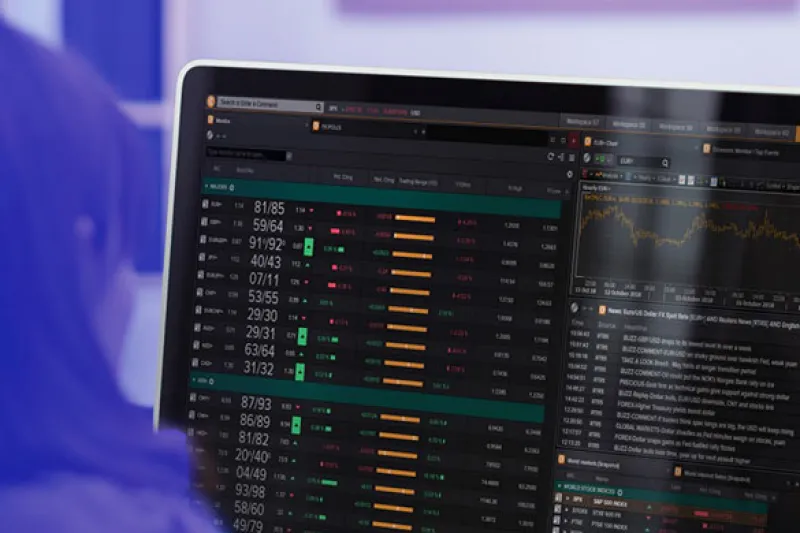Michael Rude is Head of REDI EMS & Buy-Side Trading Solutions at Refinitiv. As such, he has an unobstructed view of the evolution and adoption of electronic trading. II spoke with him to get his thoughts on how traders are benefitting from electronic trading, and new ways he is seeing them use the technology.
Where are you seeing growth in electronic trading?
The adoption of electronic trading continues to increase. The reasons vary, but for many, electronic trading has been an anecdote for fee compression, an enabler for automation and efficiency, and a catalyst for improving trade performance. Most of the adoption has been in listed, vanilla products like equities, options, and futures. More recently, we’ve seen growth in foreign exchange and fixed income. And now we’re seeing demand for virtually everything to be put on a screen for price discovery and workflow efficiencies. Clients are currently asking us to enable electronic trading in commodities, over the counter products, and user defined spreads.
What’s an example of electronic trading being applied in a wide range of sectors?
We recently launched bilateral trading functionality for our corporate clients who seek financial hedges with their bank counterparties for select commodities. Traditionally, this business was transacted using phone or chat communications, but clients want on-screen functionality for audit-trail purposes and straight-through processing.
Another example is user-defined spreads for futures and futures options. This business has also traditionally been transacted over voice, but now approximately 50 percent of those trades can be done on the screen.
What’s driving such diverse applications?
Everyone wants to do more and more on their screen, and EMS [execution management systems] can offer significant benefits to all parties in a transaction. Certainly, one of the major drivers has been the desire to reduce transaction costs through self-directed trading, taking the voice broker out of the work flow. But the benefits go way beyond lower fees. My view is that clients want automation, analytics-driven workflows, straight-through processing, and auditability.
What is the impact of all of this on the traders themselves?
Our most sophisticated clients are automating trade workflows and building decision support tools that enable the trading desk to focus on opportunities and issues. They are streamlining the “easy” trades, and shining a spotlight on exceptions, such as an order for a stock experiencing a material price and liquidity change. The objective is to augment the human trader with timely and actionable analytics that enable desks to focus on what matters, and to trade smarter.
Are there still hurdles facing the adoption of electronic trading?
Overcoming the established ways of doing business is a challenge in voice and chat-based markets. When the trading environment is opaque, there are more opportunities for brokers to make higher profits from a transaction. Liquidity providers are less inclined to adopt electronic solutions because that usually leads to price transparency, competitive pricing, and narrower spreads. For these reasons, when rolling out screens to these less-liquid markets, it takes a great deal of energy to bring the ecosystem into line, so the trading parties can cooperate more efficiently with each other. But changing an established trading environment can be difficult in the short term, even if there are clear long-term benefits.

What does the next iteration of electronic trading look like?
The next generation of EMS trading technology embeds automation and analytics in traders’ workflows, with decision support tools that focus traders’ attention on opportunities and issues. Because each client is unique, the technology will be highly configurable and rules-based to enable significant customization to satisfy each client’s specific requirements. These tools will be delivered via the cloud as software-as-a-service.
As artificial intelligence continues to evolve how will it impact advances in electronic trading?
Artificial intelligence has an endless array of applications in investment management and trading disciplines. Within electronic trading specifically, we see AI and machine learning techniques being used to create predictive analytics/signals that can be used to inform a trading decision, or to influence a trading tactic (e.g., child order placement logic).
That said, I do not see AI being used in a real-time interaction with the trading markets because of the sheer volume of data that must be processed so quickly. I do think we will see it used more often on a post-trade basis in order to create better models for future transactions.
How do you see the future of electronic trading taking shape?
My view is that every step after the investment decision will be automated in the ways discussed during this interview. Analytics and rules that are prescriptive and auditable will drive the vast majority of implementation decisions. Trading will become more data dependent and quantitatively driven, with a relentless focus on maximizing alpha capture and reducing implicit and explicit costs. Moreover, the future of trading will incorporate new sets of data that inform the trading process. For example, order-routing decisions will be driven by factors such as financing costs – something that is normally a post trade consideration.
Learn more about the evolution taking place in trading workflows.
© Refinitiv 2019. All Rights Reserved.
REDI Global Technologies LLC is a member of FINRA/SIPC. REDI Technologies Ltd. is authorized and regulated by the UK Financial Conduct Authority. This communication is only intended for institutional customers and eligible counterparties as defined by the respective regulators/authorities. REDI services and related services are not available in all jurisdictions.
The opinions expressed are those of the author(s) and do not necessarily reflect the views of the firm, its clients, or Refinitiv, or any of its respective affiliates. This article is for general information purposes and is not intended to be and should not be taken as legal advice.





